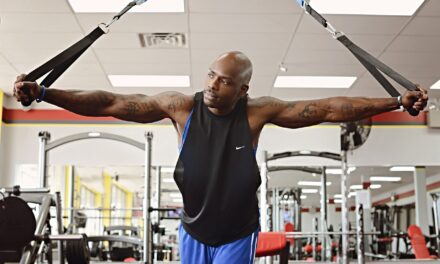The Golden Touch of Strength: Lifting More Than Just Weights
Turning the page to the second half-century of life, men often encounter a narrative that’s less about peak performance and more about gentle decline. But for the modern man over 50, that script is being rewritten, and strength training is the quill. The misconception that strength diminishes with age is being dispelled by a simple, yet profound, embrace of resistance training. This isn’t a tale of striving for the herculean physique of youth but about fostering a strength that enhances every facet of a mature life.
Embarking on a journey of strength training for men over 50 is not about recapturing youth; it’s a bold statement of intent. It’s a commitment to living fully, pushing back against the tide of age, and carving out a lifestyle that’s defined not by a number but by the vigor with which life is approached. But where does one start? Is there a secret formula, or is it as straightforward as picking up some weights? Let’s lift the veil on this transformative practice.
Strength training at this stage of life is a balancing act between respecting the body’s limits and challenging its capabilities. It’s about functional fitness—training for life, not just the mirror. Sure, a toned physique is a welcome byproduct, but the real prize is the health benefits that ripple beneath the surface. Men over 50 stand on the precipice of a golden opportunity; to strengthen bones, bolster heart health, and fortify mental well-being. It’s about setting the stage for a life where ‘over the hill’ simply means a new vantage point from which to view the horizon.
Yet, for all its benefits, entering the world of strength training can feel like stepping into a foreign land. What exercises are safe? How does one navigate the gym environment with confidence? Fear not, for this guide is your compass, pointing the way to strength training success. We’ll explore the myths, unveil the facts, and lay out a roadmap that’ll have you shouldering the mantle of strength with the ease of a man who knows that age is an accolade, not an ailment.
Understanding the Bedrock of Strength in Your Prime Years
The fountain of youth isn’t found in a bottle; it’s crafted in the gym. Strength training after 50 isn’t just a good idea; it’s your body’s plea for vitality. But understanding the science and the methodology behind strength training is crucial for it to be effective and safe. It’s not merely about hoisting weights; it’s about understanding your body’s new requirements and how to meet them.
Firstly, we must address the natural phenomenon every man faces: sarcopenia—the age-related loss of muscle mass and strength. The reality is stark; from the age of 30, men can lose 3% to 5% of muscle mass per decade. However, strength training is the ally that fights this decline, promoting muscle synthesis and boosting metabolic health. It’s a game of strategy, where consistent resistance training can not only halt the decline but can reverse the trend.
Research is on your side, showcasing that regular strength training can increase muscle mass and strength, even in the senior years. It’s about activating as many muscle fibers as possible, something that’s more efficiently done with the precision of weightlifting. But this isn’t about lifting the heaviest weights in the room; it’s about the right amount of load, the correct form, and the proper technique to stimulate muscle growth without risking injury.
Another cornerstone of strength training for mature men is bone density. Just as muscles can atrophy, so can bones weaken over time. Osteoporosis isn’t just a women’s issue; it’s a significant concern for aging men, too. Strength training exerts a beneficial stress on bones, signaling them to bolster their density and strength, laying a robust foundation for a sturdy, resilient body.
Cardiovascular health is also intimately tied to muscle mass. A strong body cultivates a strong heart. The days of endless treadmill sessions are eclipsed by the efficacy of strength training that can raise your heart rate, burn calories, and improve overall cardiovascular endurance. In this arena, consistency beats intensity. Slow and steady progression is the secret sauce to reaping lifelong benefits.
The psychological fortitude that comes with strength training cannot be overlooked. The confidence of lifting more than you did last week, the mental clarity after a session, the stress relief—these are intangible rewards that permeate every aspect of life. It’s as much about mental resilience as it is about physical prowess.
The journey into strength training must begin with a well-informed plan. Enlisting professional guidance, either through a personal trainer or reputable sources, is invaluable. It’s crucial to start with a foundational regimen that emphasizes full-body workouts, compound movements, and a balance between different muscle groups. Progression is personal and should be paced; it’s not a race, but a marathon with your well-being at the finish line.
Summary and Takeaways for Lifelong Strength
The journey of strength training for men over 50 is not just about building muscle—it’s a profound commitment to revitalizing one’s health and quality of life. The path is laid out with science-backed practices, real-life success stories, and the undeniable evidence of the benefits that strength training brings to the male body in its golden years.
Embrace the process with patience and respect for what your body can do, gradually pushing its boundaries. The combined impact of muscle growth, enhanced metabolism, fortified bones, and cardiovascular health is transformative. Strength training is a testament to the body’s remarkable ability to adapt and thrive, regardless of age.
Consistency is your most powerful tool. Make strength training a regular part of your routine, and you will see the benefits unfold not only in your physical health but in your mental and emotional well-being. The empowerment gained from strength training permeates every facet of life, from improved functional movement in daily tasks to the profound satisfaction of achieving personal health goals.
As you progress, listen to your body’s signals. Rest when needed, push when it feels right, and always prioritize proper form over lifting heavier weights. Remember, the aim is sustainable progress and health, not fleeting victories or comparison with others.
Finally, let’s revisit the core takeaways:
- Muscle Matters: Counteract age-related muscle loss with regular, targeted strength training exercises.
- Bone Health: Protect against osteoporosis and bone density loss through the stress and repair cycle initiated by weight-bearing exercises.
- Heart Health: Supplement your cardiovascular routine with strength training to improve heart health and endurance.
- Mental Resilience: Harness the psychological benefits of strength training, including increased confidence and stress reduction.
- Professional Guidance: Seek expert advice and craft a personalized plan that addresses your unique health profile and fitness level.
Incorporating these principles into your lifestyle ensures that strength training is not just a phase but a sustainable, rewarding practice that enhances your life after 50. It’s never too late to start, and the rewards are just waiting to be reaped. Strength training is not just for the young; it’s a timeless pillar of health for every man who values his vitality and vigor.






